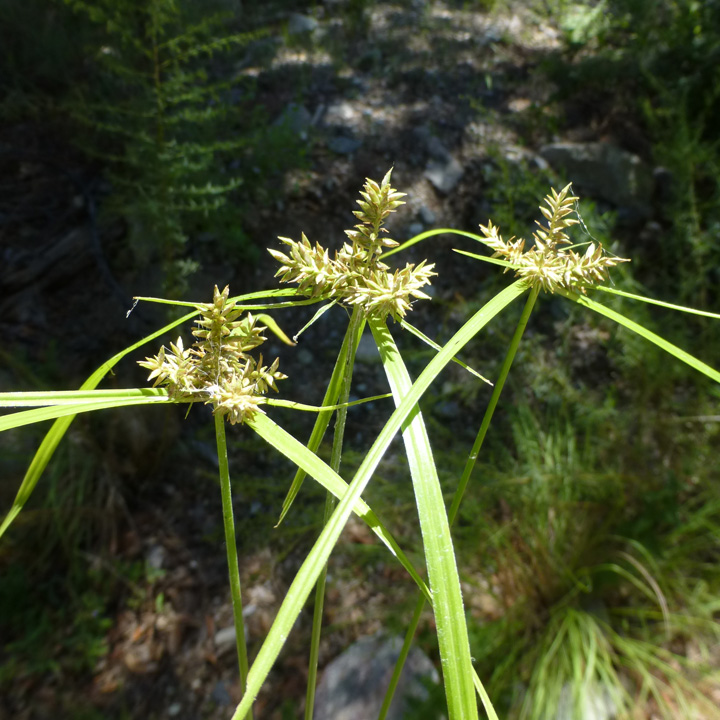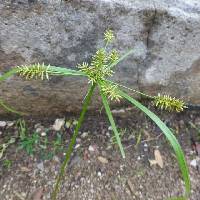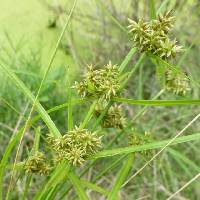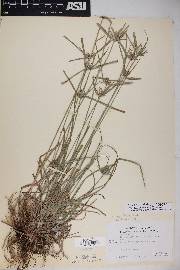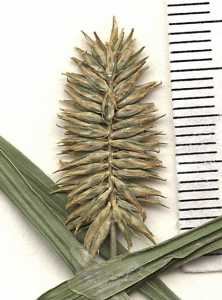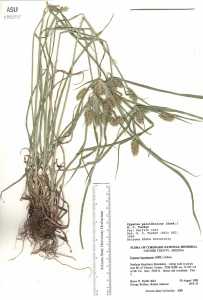|
|
|
|
Family: Cyperaceae
pallid flatsedge
|
Herbs, perennial, cespitose, rhizomatous. Culms trigonous, (10-) 30-50(-80) cm × (0.8-)1-2 mm, glabrous or occasionally minutely scabridulous on distal angles. Leaves 3-7, M- or V-shaped, (10-)25-40(-55) cm × 2-5 mm, margins and midribs scabridulous or glabrous. Inflorescences: spikes 3-6(-12), grayish to golden brown, loosely cylindric, (6-)10-20(-24) cm × (5-)8-11 mm; rays 0 or 1-3, to 4 cm; rachis glabrous; bracts (3-)4-6(-8), horizontal to strongly reflexed, inversely W-shaped, (3-) 10-20(-30) cm × 1-5 mm; rachilla deciduous, wings persistent, 0.3-0.5 mm wide. Spikelets (10-)25-60(-100), spaced 1-2(-3) mm apart, broadly ellipsoid to oblong, ± terete, 2.4-3.6 × 0.8-1.2 mm; distal spikelet spreading or ascending; floral scales persistent, 1-2(-4), appressed, laterally golden brown to dull grayish white, frequently streaked with red, medially greenish, laterally 3-4-ribbed, medially 3-ribbed, oblong, 2.6-3.3 × 1.8-2.4 mm, apex broadly rounded. Flowers: anthers 0.6-0.8 mm; styles 0.8-1.2(-1.4) mm; stigmas 1.4-2 mm. Achenes reddish brown to dark brown, stipitate, ellipsoid, (1.6-)1.8-2(-2.2) × (0.6-)0.7-0.9 mm, base cuneate to ± attenuate, apex ± acute to broadly rounded, surfaces finely papillose to essentially glabrous. Fruiting summer. Clearings in montane forests; 800-1200 m; Ariz., N.Mex.; Mexico; Central America; South America. Tucker 1994, FNA 2002 Common Name: pallid flatsedge Duration: Perennial Nativity: Native Lifeform: Graminoid General: Rhizomatous tufted perennial with rhizomes 1-3 cm long, 0.5-1 cm in diameter, stems 30-50 cm tall, three sided, smooth to rough to the touch on the angles near the tips. Vegetative: Leaves 3-7, 25-40 cm long, 2-5 mm wide, inversely w-shaped or v-shaped, margins and keel rough to the touch. Inflorescence: Subtending bracts 4-6, 10-20 cm long, 1-5 mm wide, inversely w-shaped, margins and keel rough to the touch, horizontal to reflexed downward nearly parallel to stem, rays 1-3, to 4 cm, spikes 3-6, 10-22 mm long, 8-11 mm wide, loosely cylindric, about 2-3 times longer than wide, rachis 6-20 mm long; spikelets 25-60, 2.5-3.5 mm long, about 1 mm wide, broadly ellipsoid to oblong, subterete, light green to straw colored, often red-spotted, 1-2 persistent scales, 2.5-3.5 mm long, 1.5-2.5 mm wide, oblong, streaked with red; achenes about 2 mm long, about 1 mm wide, three sided, ellipsoid, faces flat or slightly concave, surface finely papillose, reddish brown. Ecology: Found on dry to moist soils, in openings in woodlands, near seeps and springs and on disturbed sites from 5,000-9,000 ft (1524-2743 m); flowers June-October. Notes: Distinguished by the sessile spikes with lax spikelets and horizontal to reflexed inflorescence bracts. When dry, the leaves lightly curl and twist. Ethnobotany: Unknown Etymology: Cyperus is from the Greek word meaning sedge, while pallidicolor means pale colored. Synonyms: None Editor: SBuckley, 2010 |
|
|
|


